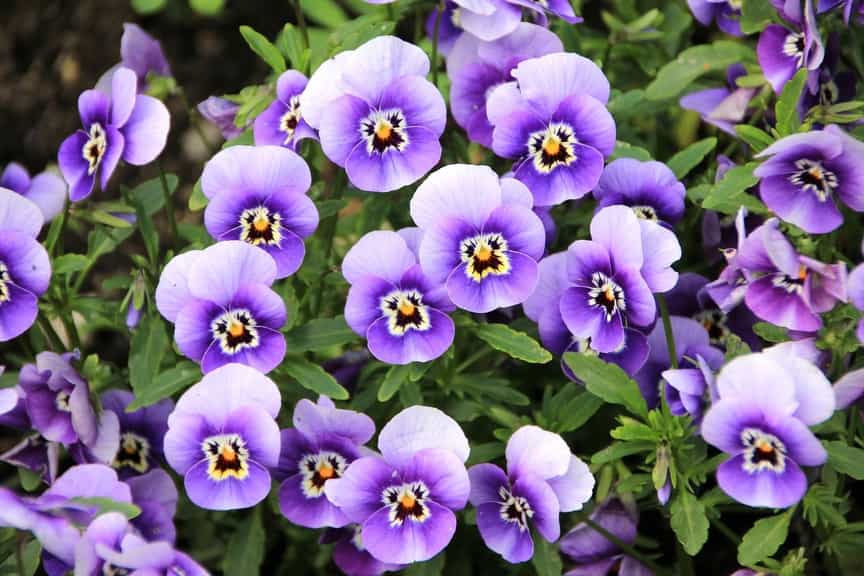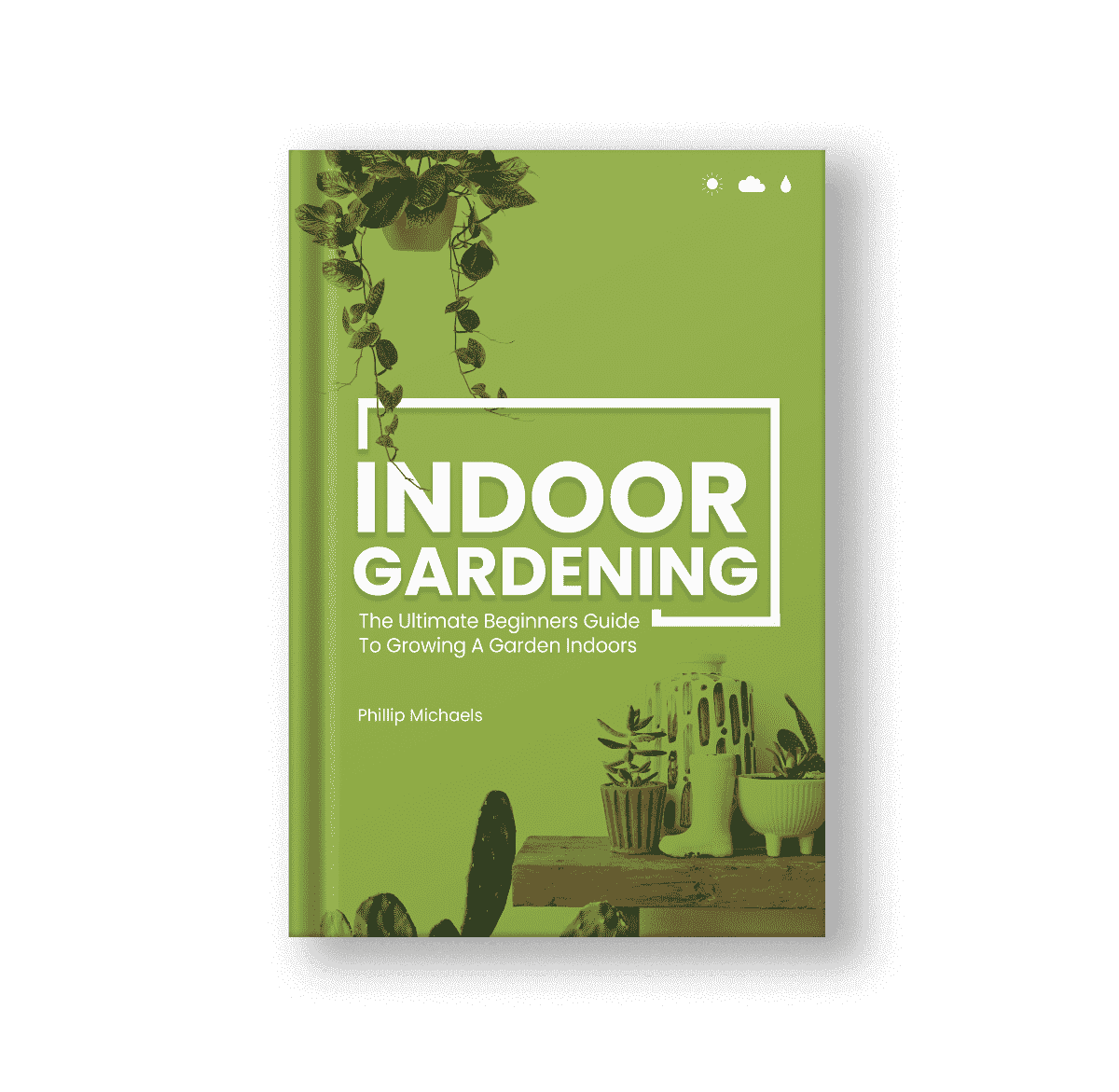Pansies are a hybrid of a variety of wildflowers that are common in areas like Western Asia and Europe. They are a popular ornamental plant in outdoor gardens, but it’s possible to grow them indoors as well. In this article, we’ll look at growing pansies indoors, and give you all the information you need to successfully grow them. They can be a bit tricky, so don’t get discouraged if it takes a while to be successful.
Pansies Quick Overview
- Pansies come in a huge range of colors and varieties. The majority of these have similar if not the same care requirements.
- A cool weather plant, they do best when kept in a cooler room and away from heat.
- Pansies do best in indirect but bright light. Too direct of light can warm them up and fry the flowers.
- Like to be moist but not soaked, use well draining soil and a container with proper drainage.
- Pansies are biennials meaning they live for 2 years. It’s easy to propagate them though, so you can ensure consistent, new growth.
Container
Pansies need good drainage to release excess moisture, so a container with a couple of drainage holes is a must. Other than this, there are no specific container requirements. Terracotta pots are a great option since the porous material absorbs some of that moisture. This further reduces the risk of overwatering.
You can also use plastic containers or galvanized buckets as long as you add drainage holes before planting. For a more appealing look, you can even grow indoor pansies in a colorful bowl or another decorative container.
For pansies planted on their own, a small pot is fine. If you’re planting a few plants in one container, then you do need to keep at least six inches between each plant, so your container needs to be large enough to accommodate this.
Soil
Pansies prefer soil that is well-draining to get rid of excess moisture. It should also be rich in nutrients to ensure that the plant is getting the right food to keep it healthy and happy.
In most cases you can use any standard potting soil designed for container gardens. You can also use a more quickly draining cacti mix, although you’ll need to water a bit more. This does reduce the change of overwatering though; this is usually the biggest cause of failed indoor pansies.
Light
A decent amount of light is a must for pansies to survive. They need at least 6 hours of bright light each day, though they aren’t fond of direct light, especially during the hottest months. Too much direct sunlight can darken the flowers and cause brittle leaves. It can also slow down the development of new blooms, so morning and evening sun is best for these plants.
You can also move the plant away from the window during the afternoon hours or use curtains to reduce the intensity of the sun’s rays. Shoot for indirect but bright light to ensure proper growth without burning out the fragile flowers.
Water
Like all plants, pansies need water to survive, though they don’t like excessive amounts of moisture. When watering, only give them about an inch of water during their growing season and even less during the colder months when the plant goes dormant.
Don’t water them too often, either. Check the soil by inserting the tip of your finger into the soil. If the soil sticks to it, the pansies aren’t ready for more water. If your finger comes out clean, add some water, though only small amounts at a time. Too much moisture could lead to root rot, which can cause severe damage or even death to your pansies.
Temperature
Though pansies grown outdoors can survive during the hot summer months, they prefer cooler temperatures. In fact, these plants thrive in the spring, long before the heat of the summer takes over.
When grown inside, these plants need to be kept at 70 degrees Fahrenheit or cooler for the best results. Temperatures any higher than this and the pansies will start to wilt. Of course, they can’t survive if it is too cold, either, so don’t let the temperature drop below 55 degrees Fahrenheit.
Humidity
Humidity is another factor that needs to be limited for pansies to thrive. Pansies generally like to be in lower humidity environments, but not overly dry. Indoor summer humidity is usually fine, but you may find the air getting a bit too dry during the winter.
To compensate, you can lightly mist your pansies every couple of days to help bring the humidity level back into balance. This should be done sparingly though, and only if the local humidity is quite low.
Fertilizer
Fertilizer is a must to ensure those distinctive flowers bloom on your pansy plants. The healthier the plant is, the larger and prettier the plants will appear, so give them the food they need to encourage this.
About four weeks after planting, add a diluted, well-balanced liquid fertilizer to encourage growth. You can also add more twice each month during the pansy’s growing season.
Pruning
Plants that get too much sun may become leggy, so these stems will need to be trimmed to prevent them from becoming damaged or breaking altogether. Removing these leggy stems can also encourage growth and more flowers for a lusher, more attractive plant.
You should also remove any dead or dry flowers. Not only do these have an unsightly appearance, but they also prevent growth, so removing them helps encourage new blooms. They’re also a haven for pests, so removing them can also help reduce the risk of an infestation.
Propagation
There are a few ways to propagate a pansy, so you can start new ones however you like. The first, and most obvious, option is to use seeds, planting them in fresh, well-draining soil mixed with perlite to improve drainage. Water them lightly and keep the temperature at about 70 to 75 degrees Fahrenheit.
You can also propagate pansies from cuttings using your healthy mature plants. Find a node on this parent plant and cut a section about 3 inches below it. Trim away the lower leaves and plant the cutting into rich, well-draining soil. The best time for this type of propagation is during the late summer or fall.
Dividing pansies is another way to create new plants. Not all pansies can be propagated this way, though, so be sure to check the variety you have before attempting this. To propagate this way, remove the plant from the pot and use your hands to gently pull it apart, ensuring each new section has roots attached. Then plant them in rich, well-draining soil.
Toxicity
Pansies aren’t just appealing in appearance, they are also quite tasty for humans to eat, due to the slight peppery or wintergreen flavor. You can add pansies to desserts, salads, soups, and many other dishes for a tasty treat.
Pets don’t have this luxury, though, since pansy plants are mildly toxic to animals. Ingesting small amounts can cause a loss of appetite, upset stomach, or diarrhea. In large quantities, convulsions, weakened heartbeats, and loss of consciousness could also result, so keep your pets clear of these pretty plants.
Growing Pansies Indoors
Pansies are beautiful flowers that don’t just need to be confined to outdoor gardens. With proper planning, it’s possible to grow these delightful flowers indoors. With the above information, you’re well equipped to grow your own beautiful, pansy garden.
Growing Pansies Indoors FAQ
Are Pansies Difficult To Grow Indoors?
Pansies can be a bit tricky to grow indoors due to their care needs being a bit better suited to outdoors. In particular, their cool weather nature means indoor temperatures can often be too high for them.
What Special Care Do Pansies Need To Grow Indoors?
The two biggest indoor issues for pansies are temperature and humidity. You want to keep them at a relatively low temperature, and keep the humidity balanced. They don’t like being too warm, nor do they want an overly humid or excessive dry environment.
Are Pansies Safe To Grow?
Panies are toxic to pets so they should be kept out of reach of curious cats and dogs. They are generally safe for human consumption though.







